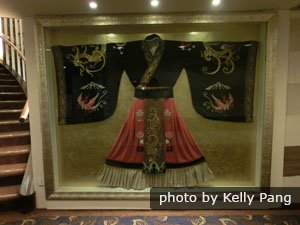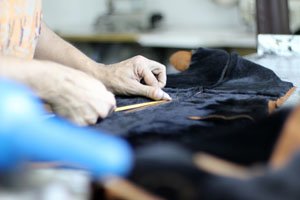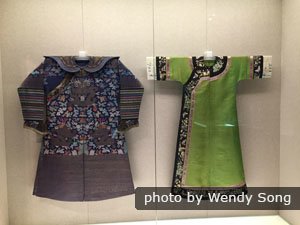Traditional Chinese clothes were an evolution of their long, loose, straight-cut jackets and pants or gowns. They reflected traditional Chinese aesthetics, philosophy, and social values as they changed through over 3,000 years of history.
4 Well-Known Traditional Chinese Clothes Types
Each country in the world has its own unique traditional clothes, from which people are able to distinguish one country from another, and so it has been with China.
The Hanfu, Zhongshan suit (Mao suit), Tang suit, and cheongsam (qipao) are the four most distinctive types of traditional Chinese clothing.
1. Hanfu

The Hanfu ('Han clothing' — the majority of Chinese are of Han ethnicity) is the oldest of China's traditional clothes. Legend traces it back to over 4,000 years ago when Huangdi's consort, Leizu, made cloth with silk. It was constantly improved throughout several dynasties.
Until the Han Dynasty, the Hanfu was adopted and vigorously promoted by the ruling class. It then became the national clothing of the Han ethnic people. It also had a far-reaching influence on neighboring Asian countries, such as Korea, Japan, and Vietnam.
2. Zhongshan Suit
The Zhongshan suit, also known as the Mao suit overseas, is a type of male attire. It was first advocated by Dr Sun Yat-sen (i.e. Sun Zhongshan, hence Zhongshan suit) after the founding of the Republic of China in 1912.
Later on, after Chairman Mao had been seen wearing it in public numerous times, this outfit gained the name "Mao suit". Read more on the Zhongshan suit.
3. Tang Suit

The Tang suit often refers to a type of Chinese jacket rather than the clothing of the Tang Dynasty (618–907). This name came from the overseas Chinese.
As the Tang Empire was famous for being prosperous and powerful in the world, foreigners called the overseas Chinese people "the Tang people" and the clothes they wore were called "Tang suits" (which has been translated as Tangzhuang 唐装). Read more about the Tang suit.
4. Cheongsam
The cheongsam (qipao) evolved from the Manchu women's changpao ('long gown') of the Qing Dynasty (1644–1912). The Manchu ethnic people were also called the Qi people by the Han people; hence their long gown was named qipao ('Qi gown'). Read more about the cheongsam.
5 Key Variations in Traditional Chinese Clothing
There were no fashion shows in ancient China. Traditional Chinese clothing was the outcome of people's aesthetic tastes and social customs. It varied historically, regionally, and through the social hierarchy.
1. Design
Traditional Chinese clothes usually adopted a straight cut and were loose in shape. In addition, the overall harmony of the outfit was also emphasized.
2. Color
People normally wore light colored clothing in daily life. Red, bright yellow, and purple always exclusively belonged to the emperor and the imperial family. The mass people mostly wore red at weddings. Besides that, white clothing was normally worn at a funeral.
For example, for women, only an empress or official wives could wear true red while the color was prohibited to concubines.
3. Gender
Women's clothing was more diverse than clothing for men. Compared to men's clothing, women's clothing had more ornaments, items, and styles.
4. Material

At the very beginning, the ancient Chinese only covered their bodies with leaves. As agricultural development increased, more clothing material appeared. In later years, linen, cotton, and silk were the prominent materials.
During the Ming Dynasty (1368–1644), according to the government's policy of physiocracy and restriction of business, businessmen were forbidden to wear silk clothing, even if they were rich.
5. History
Almost every dynasty had its own unique clothes, some of which were really exquisite beyond compare. Read more on the Development of Traditional Chinese Clothes.
The 2 Basic Forms of Traditional Chinese Clothes
Generally, traditional Chinese clothes had two basic forms: top-bottom clothes and one-piece clothes.
Two-Piece Clothing
The top-bottom clothes, consisting of an yi (衣 upper garment) and a chang (裳 lower garment) were the earliest form of clothing recorded in Chinese documents. This two-piece clothing is said to date back to legendary Huangdi's reign (2697–2597 BC).
The yi refers to any open cross-collar garment worn by both sexes, where the right side was wrapped over the left, and the shang refers to any skirt worn by both sexes, highlighted by a belt hanging from the side.
One-Piece Clothing

The one-piece clothing was called shenyi (deep robe) and can be traced back to the late Zhou Dynasty (1046–221 BC). The yi and the shang were sewn as one piece although they were cut separately.
The shenyi was widely adopted by various dynasties throughout the history of China. It was considered to be formal dress in the Han Dynasty (206 BC – 220 AD), and it still has a great influence on modern-day one-piece clothing.
